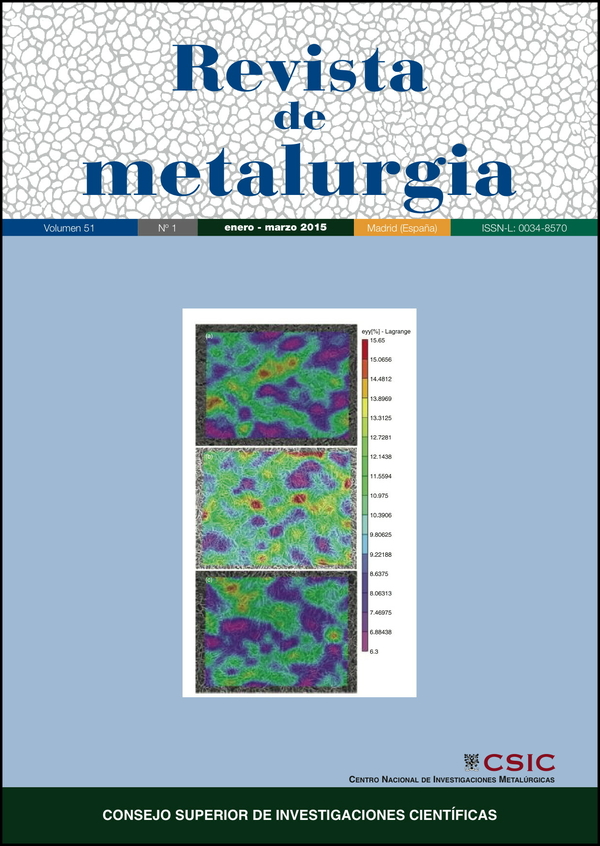Multiobjective optimization of GMAW process of the AA 6063-t5 alloy based on penetration and heat affected zone
DOI:
https://doi.org/10.3989/revmetalm.037Keywords:
Aluminum, GMAW, Optimization, Response Surface Methodology (RSM)Abstract
The selection of technological parameters in a welding process must be led to the optimized results of the operation. Penetration is one of the most decisive factors for the success of the joint. Another important factor is the Heat Affected Zone (HAZ), when the mechanical properties of this one are modified respecting to the base material. The way in which the technological variables of the process affects to both them, penetration and HAZ, are inverse in each case. This work presents an optimization methodology based on the Design of Experiments (DOE) and the Response Surface Method (RSM) of the GMAW process applied to the aluminum alloy AA 6063-T5. This research is focused to obtain penetration rates that make HAZ values to be suitable in current applications. Welding rate has been found to be the most significant technological parameter for controlling the process.
Downloads
References
Dorta, M., Vidal, J., Mateo, A., Fargas, G., Camejo, F. (2011). Modelos empíricos para la predicción de la geometría del cordón en soldaduras a tope de un acero inoxidable dúplex 2205. Dyna 78 (169), 206–215.
Karadeniz, E., Ozsarac, U., Yildiz, C. (2007). The effect of process parameters on penetration in gas metal arc welding processes. Mater. Desing 28 (2), 649–656. http://dx.doi.org/10.1016/j.matdes.2005.07.014
Kim, I.S., Son, J.S., Kim, I.G., Kim J.Y., Kim, O.S. (2003). A study on relationship between process variables and bead penetration for robotic CO2 arc welding. J. Mater. Process. Tech. 136 (1–3), 139–145. http://dx.doi.org/10.1016/S0924-0136(02)01126-3
Martínez, A., Miguel, V., Coello, J., Navarro, A., Calatayud, A., Manjabacas, M.C. (2011). Influencia de la técnica de soldadura multipasada y de los tratamientos térmicos de precalentamiento y post-soldadura en el comportamiento de uniones GMAW de un acero microaleado HARDOX 400. Rev. Metal. 47 (1), 61–75. http://dx.doi.org/10.3989/revmetalmadrid.1007
Kim, I.S., Park, C. E., Jeong Y. J., Son, J. S. (2001). Development of an intelligent system for selection of the process variables in gas metal arc welding processes. Int. J. Adv. Manuf. Technol. 18, 98–102. http://dx.doi.org/10.1007/s001700170080
Mc Glone, J.C., Chadwick, D.B. (1978). The submerged arc butt welding of mild steel. Part 2. The prediction of weld bead geometry from the procedure parameters. Welding Institute Report 80, 256–263.
Miguel, V., García-Conesa, E.J., Segura, F., Manjabacas M.C., Abellán, E. (2012). Optimización del proceso de soldadura GMAW de uniones a tope de la aleación AA 6063-T5 basada en la metodología de superficie de respuesta y en la geometría del cordón de soldadura. Rev. Metal. 48 (5), 333–350. http://dx.doi.org/10.3989/revmetalm.1169
Miguel, V., Martínez, A., Manjabacas, M.C., Coello, J., Calatayud, A. (2009). Electrical Evaluation Of Welding Machines Based On The Arc Properties. Application To SMAW, GMAW And GTAW Processes. AIP Conference Proceedings 1181, New York, USA, pp. 170–179. http://dx.doi.org/10.1063/1.3273627
Murray, P.E., Scotti, A. (1999). Depth of penetration in gas metal arc welding. Sci. Technol. Weld. Joi. 4 (2), 112–117. http://dx.doi.org/10.1179/136217199101537644
Norma UNE-EN ISO 18273 (2005). Consumibles para el soldeo. Electrodos de alambre, alambres y varillas para el soldeo del aluminio y aleaciones de aluminio.
Norma UNE-EN ISO 6507-1 (2006). Materiales metálicos. Ensayo de dureza Vickers. Parte 1: Método de ensayo.
Payares, M.C., De Barros, C., Mu-oz, P., Cassier, Z. (1997). Modelo para la determinación del área del cordón en soldaduras a tope de aluminio 6063-T5. Rev. LatinAm. Metal. Mater. 17 (1), 5–12.
Wahab, M.A., Painter, M.J. (1997). Numerical models of metal arc welds using experimentally determined weld pool shapes as the representation of the welding heat source. Int. J. Press. Ves. Pip. 73 (2), 153–159. http://dx.doi.org/10.1016/S0308-0161(97)00049-5
Published
How to Cite
Issue
Section
License
Copyright (c) 2015 Consejo Superior de Investigaciones Científicas (CSIC)

This work is licensed under a Creative Commons Attribution 4.0 International License.
© CSIC. Manuscripts published in both the printed and online versions of this Journal are the property of Consejo Superior de Investigaciones Científicas, and quoting this source is a requirement for any partial or full reproduction.
All contents of this electronic edition, except where otherwise noted, are distributed under a “Creative Commons Attribution 4.0 International” (CC BY 4.0) License. You may read the basic information and the legal text of the license. The indication of the CC BY 4.0 License must be expressly stated in this way when necessary.
Self-archiving in repositories, personal webpages or similar, of any version other than the published by the Editor, is not allowed.
















